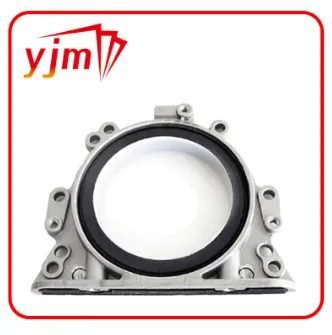Advanced Sealing Technologies: Exploring the Range of Modern Oil Seals
In machinery, automotive systems, and industrial applications, choosing the right sealing solution is essential to ensure performance, longevity, and safety. From simple static gaskets to advanced rotary seals, technology has evolved to meet high demands. Among the most important components are rubber oil seals, PTFE oil seals, double lip oil seals, and other specialized options like Polypac seals and hub oil seals. This article will examine these seals, their applications, and how high pressure seals are changing the game for modern machinery.

The Versatility of the Double Lip Oil Seal
The double lip oil seal is a popular design used to improve sealing performance in applications where dirt exclusion and lubricant retention are both critical. As the name suggests, it features two sealing lips:
Primary lip – retains the lubricant inside the system
Secondary (dust) lip – keeps contaminants like dirt, water, or debris out
This dual-action design makes the double lip oil seal ideal for:
Agricultural and construction equipment
Off-road vehicles and trailers
Industrial machinery exposed to outdoor environments
Advantages of a double lip oil seal include:
Extended seal life
Reduced maintenance frequency
Better protection in harsh or dirty environments
When paired with high-grade elastomers or polymers, double lip oil seals can also withstand moderate pressure and temperature fluctuations, further enhancing their performance.
High-Performance Materials: PTFE Oil Seals and Rubber Oil Seals
Choosing the right material is essential when selecting an oil seal. Two of the most widely used materials are PTFE (polytetrafluoroethylene) and rubber, each with distinct characteristics.
PTFE Oil Seal
PTFE oil seals are designed for extreme applications involving:
High speeds
Chemical exposure
Wide temperature ranges
Dry running conditions
Properties of PTFE oil seals:
Excellent chemical resistance
Can operate without lubrication
Low friction and wear
Ideal for food-grade, pharmaceutical, and aerospace industries
These seals are typically found in:
High-performance engines
Vacuum pumps
Aggressive chemical environments
Thanks to their adaptability, PTFE oil seals are rapidly becoming the seal of choice for advanced and demanding engineering applications.
Rubber Oil Seal
The rubber oil seal is a more traditional and cost-effective choice, widely used in automotive and general industrial applications. Typically made from nitrile rubber (NBR), fluoroelastomer (FKM), or silicone, rubber oil seals offer:
Good elasticity and flexibility
Compatibility with many oils and greases
Affordable and easy to install
Rubber oil seals are the go-to solution for low to moderate pressure environments and remain a staple in many mechanical designs due to their balance of performance and cost.
Specialized Sealing Solutions: Polypac Seals, Hub Oil Seals, and High Pressure Seals
As sealing requirements become more complex, manufacturers have developed specialized designs such as Polypac seals, hub oil seals, and high pressure seals to address unique challenges.
Polypac Seals
Polypac seals combine multiple materials and geometries to deliver superior sealing performance in dynamic hydraulic systems. Often used in:
Hydraulic cylinders
Mobile equipment
Industrial machinery
These seals are engineered for high-speed reciprocating motion and are made from a blend of rubber and thermoplastic materials to resist extrusion, wear, and pressure.
Advantages:
Excellent sealing under high pressure
Long service life in hydraulic systems
Low friction, reducing energy loss
Hub Oil Seals
A hub oil seal is designed specifically for wheel hubs and axle assemblies, particularly in heavy-duty trucks, trailers, and off-road vehicles. These seals prevent gear oil or grease from leaking out while keeping dirt and moisture from entering the hub assembly.
Key features:
High load-bearing capabilities
Resistance to road debris and moisture
Dual lip or triple lip configurations for added protection
Replacing a failed hub oil seal quickly is critical, as failure can lead to wheel bearing damage and unsafe driving conditions.
High Pressure Seal
In some environments, traditional seals simply can’t handle the demands. That’s where the high pressure seal comes in. Designed to withstand internal system pressures exceeding 5,000 psi, these seals are found in:
Hydraulic pumps
Oil and gas applications
High-pressure valve assemblies
Materials used for high pressure seals often include reinforced PTFE, polyurethane, or metal-reinforced elastomers. These seals offer:
Minimal leakage under extreme pressure
High durability and wear resistance
Compatibility with aggressive fluids
Whether it’s a basic rubber oil seal for an engine or a sophisticated PTFE oil seal for a high-speed pump, choosing the right seal is essential for performance and durability. Specialized options like the double lip oil seal, Polypac seals, and hub oil seals provide tailored solutions for unique mechanical challenges. And in environments where standard seals fail, the high pressure seal delivers the strength and reliability required.
The sealing industry continues to innovate, offering materials and designs that meet the ever-evolving demands of modern equipment. Understanding your specific application needs—and the strengths of each seal type—ensures long-term reliability and system protection.
-
Seal 12x20x5: Precision Radial Shaft Seals for Industrial Reliability
သတင်း Nov.24,2025
-
Seal 12x18x5: Essential Guide to Specifications, Applications & Vendors
သတင်း Nov.24,2025
-
Understanding Seal 12 20 5: Applications, Specifications & Industry Insights
သတင်း Nov.23,2025
-
Durable Oil Seal 85x110x12 – Reliable Sealing Solutions for Industry
သတင်း Nov.23,2025
-
Durable and Precise Oil Seal 75x95x10 for Efficient Machinery | YJM Seal
သတင်း Nov.22,2025
-
Durable Oil Seal 75x100x10 for Reliable Industrial Performance | YJM Seal
သတင်း Nov.22,2025
-
High-Quality Oil Seal 65x90x10 | Durable & Reliable Sealing Solutions
သတင်း Nov.22,2025
ထုတ်ကုန်အမျိုးအစားများ















